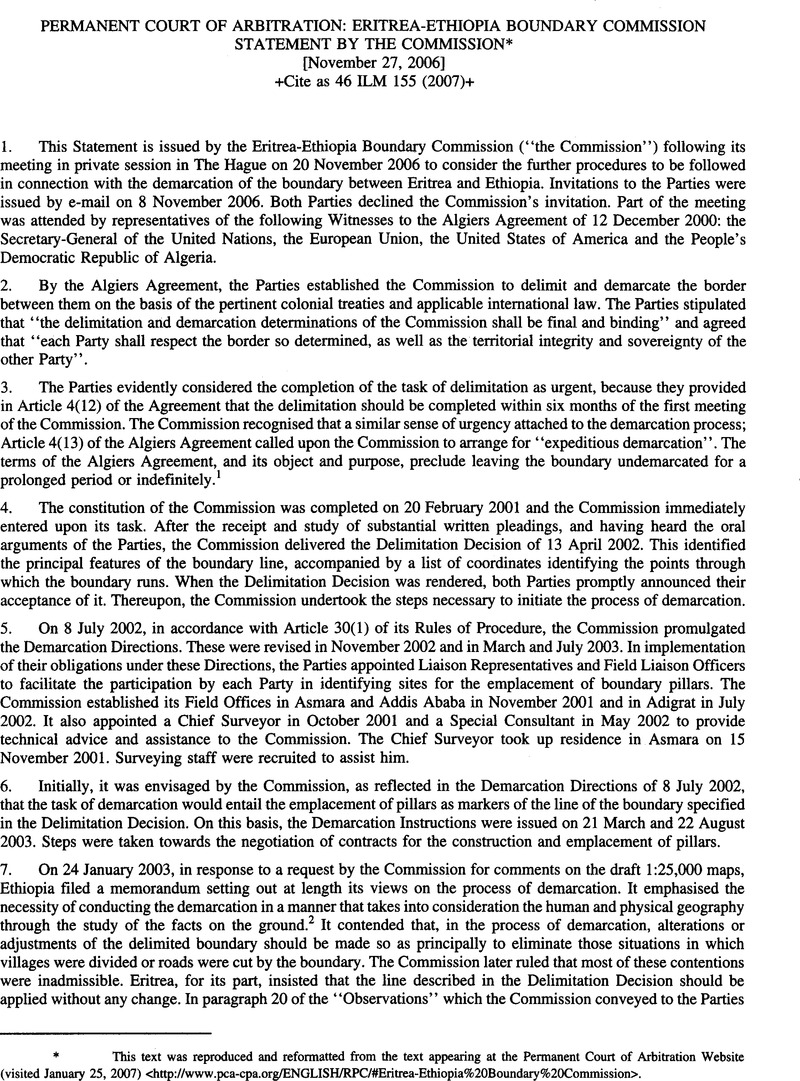No CrossRef data available.
Article contents
Permanent Court of Arbitration: Eritrea-Ethiopia Boundary Commission Statement by the Commission
Published online by Cambridge University Press: 27 February 2017
Abstract

- Type
- Judicial and Similar Proceedings
- Information
- Copyright
- Copyright © American Society of International Law 2007
References
* This text was reproduced and reformatted from the text appearing at the Permanent Court of Arbitration Website (visited January 25, 2007) <http://www.pca-cpa.org/ENGLISH/RPC/#Eritrea-Ethiopia%20Boundary%20Commission>.
1 The Commission recalls the observation of the Court of Arbitration in the Beagle Channel case - albeit in a somewhat different context: “It is not admissible that, because of the total non-cooperation of one of the Parties, contrary to its obligation under a valid Award, the Court should be compelled to remain indefinitely in existence in a state of suspended animation”. (See 52 International Law Reports 284.) The present case is not one involving the total non-cooperation of one Party, but rather the non-cooperation of both Parties, though in differing ways and degrees. Thus, the observation of the Beagle Channel tribunal applies a fortiori.
2 Submission by the Federal Democratic Republic of Ethiopia, 24 January 2003, Comments Pursuant to the December 2000 Agreement, the Commission's Rules of Procedure, the Commission's Demarcation Directions and Instructions provided at the Boundary Commission's Meeting on 6 and 7 November 2002, p. 61-74.
3 S/RES/1398 (15 March 2002), S/RES/1430 (14 August 2002), S/RES/1466 (14 March 2003), S/RES/1507 (12 September 2003), S/RES/1531 (12 March 2004), S/RES/1560 (14 September 2004), S/RES/1586 (14 March 2005), S/RES/1622 (13 September 2005), S/RES/1640 (23 November 2005), S/RES/ 1661 (14 March 2006), S/RES/1670 (13 April 2006), S/RES/ 1678 (15 May 2006), S/RES/1681 (31 May 2006 and S/RES/ 1710 (29 September 2006).
4 A comparable, though not identical, situation arose in the Argentina-Chile Frontier Case (1966) (38 International Law Reports 10), where aerial photography was used to identify points on the boundary. In the Dispositif of the Report of the Tribunal, the boundary was described in part as following the thalweg ‘ ‘of the Encuentro to Point A at the Confluence''. The following is attached to the text at this point:’ “The location of Point A and subsequent Points is shown on the diagram and air photographs incorporated in this Report. The diagram is not intended as an authoritative map. It is only an index to the air photographs. These photographs are the sole authority for the exact location of the points.” (p. 98).
5 U.N. doc. S/22558, Report of the Secretary-General regarding paragraph 3 of Security Council resolution 687 (1991), paras. 3-4, 2 May 1991.
6 Final Report on the Demarcation of the International Boundary between the Republic of Iraq and the State of Kuwait by the United Nations Iraq-Kuwait Boundary Demarcation Commission, S/25811, para. 13; also reproduced in 94 International Law Reports 1.
7 Ibid., para. 112.


